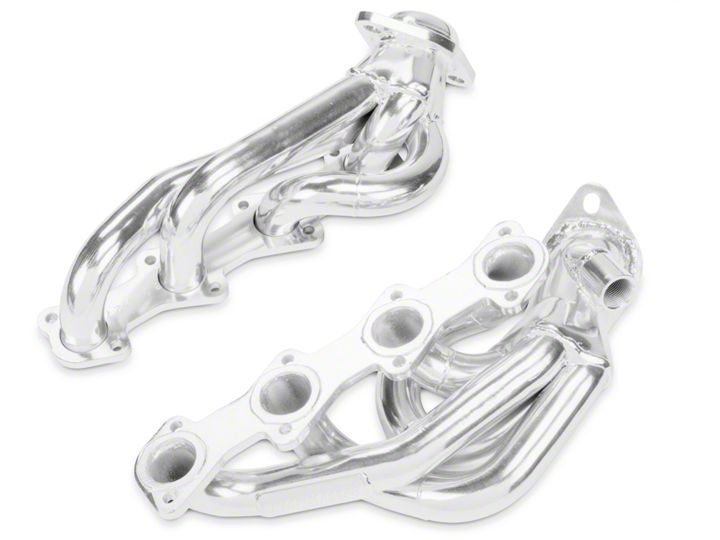
How to Install Flowmaster 1-1/2 in. Scavenger Series Elite Shorty Headers on your F-150

Shop Parts in this Guide
The product accompanying this document has been granted a California Air Resources Board (CARB) exemption, an “E.O.” number, or is a direct or consolidated replacement part. It is 50-state legal, per the manufacturer’s application guide.
Note: Installation of this product requires an adequate work space, general mechanic’s tools, general mechanical “know how” and a reasonable level of experience. Most auto enthusiasts with these resources will have little difficulty installing these headers. However, you should carefully read these instructions before attempting to install these headers. If in doubt, consult a professional mechanic. (Better to do it now than to get
stuck halfway through the installation.) This part is certified for use on Pollution Controlled Vehicles.
Check to make sure that you have received the proper parts for your installation. The header number will be stamped on the engine flange. If you are unsure you have received the proper parts call before you start work.
Be sure to work safe! Whenever you work under the vehicle be sure that it is located on level, solid ground and is supported by adequate safety stands. Remember: hot asphalt will not support most jack stands!
Many factors affect the installation of headers, some of which are; broken or aftermarket motor mounts, accidents that impact the configuration of the frame, and/or the installation of different engines or aftermarket cylinder heads.
Attention Customers breaking in new engines: Due to the extreme heat generated during the break-in process, the appearance of the ceramic coating may be altered in certain areas. The protection characteristics and thermal barrier properties of the coating is never compromised. It is recommended that a cast iron manifold or old set of headers be used for this process.
The purchaser is responsible for following all installation instructions and safety guidelines supplied with your new Flowmaster Performance Exhaust Product. Flowmaster Performance exhaust assumes no responsibility for damages resulting from improper operation, misuse, abuse, or lack of reasonable care, or any problems
resulting from incompatibility with other manufacturer’s products.
Flowmaster uses sealing beads on its headers. We have found that when installed correctly, the raised bead around each port increases the pressure exerted on the gasket directly adjacent to the port and effectively prevents leaking gaskets. It is normal for the flange to be raised off the cylinder head the thickness of the
sealing bead. It is important when installing the header, to install all bolts loosely, and then tighten evenly to ensure the flat installation of the flange. The torque sequence from one flange to another will vary, but generally every bolt on a header should be first fit snug, starting from the inside of the flange working out, alternating from top to bottom so that the bolt connects the flange to the manifold to the point where they barely touch. Second, using the same inside-out pattern, tighten each bolt until finished. This method will help prevent leakage and will give the user the best possible performance out of their new set of headers.
1) Place the vehicle in a location where the floor is solid and flat, with adequate lighting. Do not attempt to work on a hot engine. Heat causes metal to expand and makes removal of fasteners difficult at best. Disconnect the battery cables from the battery. Raise the front of the vehicle to obtain adequate access to the bottom exhaust manifold flanges. Use large base jack stands to support the vehicle. Do not rely on the jack! Block the tires to prevent the vehicle from rolling off of the jack stands.
2) Spray WD-40 or some type of penetrating lubricant on all accessible exhaust manifold fasteners and fittings before attempting to remove them. Also spray the rubber hangers that support the exhaust system.
3) From underneath the vehicle, loosen the bolts connecting the exhaust system to the exhaust manifolds. (On 4x4 models, disconnect the front drive shaft by removing the 4 bolts on the companion flange and let the drive shaft hang out of the way.) Pry the exhaust system back ½” to gain workspace.
4) Remove the front wheels. It is not necessary to remove the inner fender wells but it makes the installation easier. To remove the fender wells, simply unscrew all of the sheet metal screws and fasteners attaching it to the fender and frame and the fender well will drop out.
5) Working through the fender well on the driver’s side, loosen the EGR tube from the manifold. Then remove the nuts attaching the manifold to the head. Remove the manifold. You must also remove the studs attaching the manifold to the head. The studs have a 5mm hex end on them, a ¼” drive ratchet and a 5mm socket works well for removing the studs.
6) The dipstick must now be removed. It has a separate mounting bolt on the head and uses and Oring seal on the bottom. Use care to protect the O-ring.
7) On the passenger side, again working through the fender well, remove the nuts attaching the manifold to the head then remove the manifold. Remove the studs attaching the manifold to the head using the tools described in step 5 above.
8) Clean the head surface of any carbon deposits or high spots with a scraper or wire brush being careful not to gouge the head surface.
9) Remove the EGR fitting from the factory manifold and install it into the new header.
10) Apply a small amount of O2 sensor safe RTV silicone to the exhaust pipe flare then install the driver’s side header from underneath the vehicle. Some twisting and wiggling of the header is necessary to get the header into place. Attach the header using the supplied bolts, gaskets and lock washers and torque to 23 ft./lbs. Be sure to apply a small amount of anti-seize to the threads of the bolts before tightening. The EGR tube must now be loosened at the EGR valve (from the top) and attached to the fitting on the header. Re-install the dipstick. Tighten the EGR tube.
11) Apply a small amount of O2 sensor safe RTV silicone to the exhaust pipe flare then install the driver’s side header through the wheel well. Attach the header using the supplied bolts, gaskets and lock washers and torque to 23 ft./lbs. Be sure to apply a small amount of anti-seize to the threads of the bolts before tightening.
12) Reconnect the exhaust system to the new headers using the hardware provided. (Reconnect the drive shaft where applicable.)
13) Reinstall the fender wells if removed. Check to make sure that there is adequate clearance around all brake lines, A/C lines and wire looms, etc.
14) Reinstall the front wheels and torque to factory specs. (See owner’s manual.)
15) Reconnect the battery and recheck all steps to verify everything has been done properly.
16) Start the engine and check for leaks. After test driving the vehicle shut the engine off and allow the engine to cool. Recheck the header bolts for correct tightness. Periodically check and retighten the header bolts.
Parts List
Qty Description
(1) Drivers’ Side Header Assembly.
(1) Passenger Side Header Assembly
(2) Header Flange Gaskets
(16) 8mm x 25mm Header bolts w/lock washers
(4) Collector Bolts with nuts
(1) CARB Emissions Sticker
(1) Flowmaster Decal

